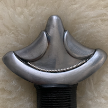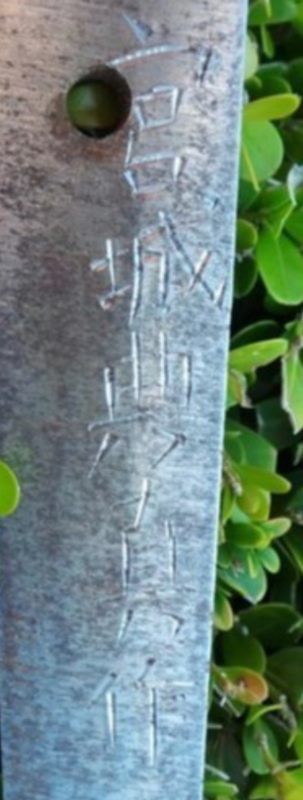-
Posts
279 -
Joined
-
Last visited
-
Days Won
2
Content Type
Profiles
Forums
Events
Store
Downloads
Gallery
Everything posted by xiayang
-
備後三次住田村正行作 = Bingo Miyoshi-jū Tamura Masayuki saku (made by Tamura Masayuki, resident of Miyoshi in Bingo province)
-
Fuchi: 乙柳軒 味墨 = Otsuryûken Miboku Tantō: 城慶子正明 = Jōkeishi Masaaki 慶應二年八月日 = on a day in the eighth month of Keiō 2 (1866 CE)
-
濃州住井戸秀俊作之 = made by Ido Hidetoshi, resident of Nōshū
-

Need help with this Horse Wakizashi sword identification.
xiayang replied to standupdann's topic in Translation Assistance
因州鳥取住正則 = Masanori, resident of Tottori in Inshū -
Hi John, Suifu (水府) is the name of a village in Hitachi province. The formatting of this mei is slightly unusual, with the two characters of Suifu being arranged horizontally (and read right-to-left) at the top, and one would ordinarily also expect them to be followed by "住", but I guess the smith took some artistic licence here.
-
慶應四年七月日 = on a day in the seventh month of of Keiō 4 (1868 CE) 水府 稲延徳正作 = Suifu Inanobe Norimasa saku
-
Most of this is beyond my reading skills, but the characters in the leftmost column in the first and fourth images are a name: 山田耕三郎 (Yamada Kōzaburō, probably this guy).
-
法师/法師 is a Buddhist monk title (cf. Dharmabhāṇaka)
-
義次 = Yoshitsugu 昭和十九年十月 = October of Shōwa 19 (1944 CE)
-
Well, I suppose it does try to say 本間 雅晴 將官 = General Masaharu Homma but this was evidently written by a 4-year old.
-
I believe it says: 嶽家劍法 (something like "Yue family sword fighting style"), where Yue refers to the Chinese Song dynasty general Yue Fei (嶽飛) who was known for his martial prowess.
-
土州住伊藤英吉造 = Tosa-jū Itō Hideyoshi tsukuru 文化十年二月日 = on a day in the second month of Bunka 10 (1813 CE)
- 1 reply
-
- 5
-

-
越前住 = Echizen-jū 伯耆守藤[原] ... = Hōki no Kami Fuji[wara] ... The smith's name was lost to suriage.
-
関住川崎兼泉作 = Seki-jū Kawasaki Kanezumi saku Not a lot of information about this smith apart from an old thread here:
-

Translation needed for this old blue paper
xiayang replied to Volker62's topic in Translation Assistance
It's an old Kōshu Tokubetsu Kicho (甲種特別貴重) paper, more details here. The handwritten part mentions both the katana (刀) and the wakizashi (脇指), with common signatures (銘) of 河内大掾藤原國定 (Kawachi Daijō Fujiwara Kunisada) and lengths (長) of 70.9 cm (二尺三寸四分) and 54.2 cm (一尺七寸九分), respectively. -
The first sword does not look Japanese-made to me. The second one is more interesting, but unfortunately the last character is a bit out of focus in your image: 肥州住忠[?] = Hishū-jū Tada[?]
-
濃州住森俊治作 = Nōshū-jū Mori Toshiharu saku
-

Recently Purchased Collection of 3 Gunto
xiayang replied to Fusilier's topic in Translation Assistance
Second blade: 氏房 = Ujifusa 昭和十六年 = Shōwa 16 (1941 CE) Third blade: 西部宗命 = Seibu Munenaga -
Hi Michael, The blade is signed 豊州住藤原正行 = Hōshū-jū Fujiwara Masayuki
-

Shin-gunto, Seki - Tang translation help.
xiayang replied to Robbitybob's topic in Translation Assistance
Hi Rob, Yep, that's pretty much it. You can find more information about the smith in this thread: -

Shin-gunto, Seki - Tang translation help.
xiayang replied to Robbitybob's topic in Translation Assistance
濃州住塚原兼次謹作 = Nōshū-jū Tsukahara Kanetsugu kinsaku -
That‘s correct: 豊後住藤原實行 = Bungo-jū Fujiwara Saneyuki
-
Have a close look at the placement of the mei the proportions of the individual characters the proportions of the characters relative to each other the execution of the characters (e.g., depth, width and shape of strokes) One of them is consistent with a master craftsman putting the final touch on a work of art that took hundreds of hours to create. The other one is sloppily executed with poor calligraphic aesthetics...





